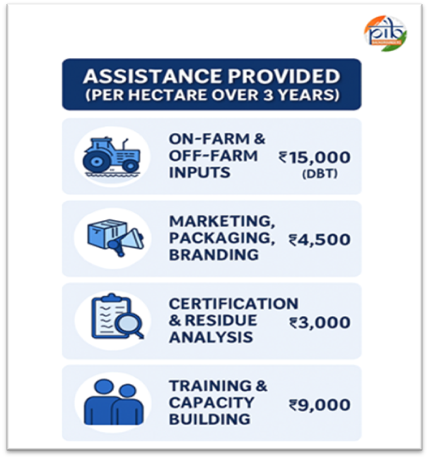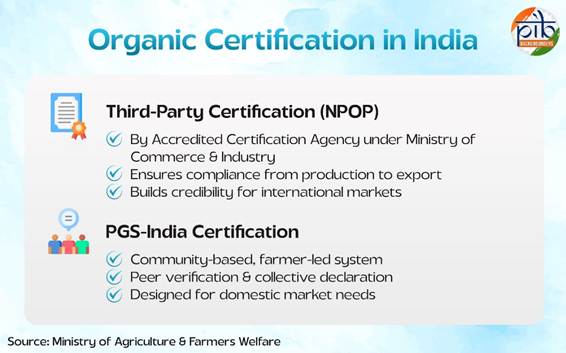Important Facts For Prelims
Paramparagat Krishi Vikas Yojana (PKVY)
- 11 Oct 2025
- 5 min read
Why in News?
Over the past 10 years, Paramparagat Krishi Vikas Yojana (PKVY) has become a cornerstone of India’s sustainable agriculture initiatives.
- Due to soil degradation, water pollution, and chemical residues, India launched PKVY in 2015 to promote organic farming, increase farmer incomes, and support sustainable agriculture.
What is Paramparagat Krishi Vikas Yojana?
- About: PKVY is part of the Soil Health Management (SHM) component under the National Mission on Sustainable Agriculture (NMSA).
- The scheme aims to support and promote organic farming, leading to improvements in soil health.
- Promotes the Participatory Guarantee System (PGS) for India, a locally relevant organic certification based on mutual trust, involving both producers and consumers.
- PGS-India operates outside the "Third Party Certification" system.
- Funding Pattern:
- Central and State Governments share the funding in a 60:40 ratio.
- For North Eastern and Himalayan States, the funding ratio is 90:10 (Centre: State).
- For Union Territories, the assistance is fully funded by the Central Government (100%).
- Eligibility: All farmers and institutions are eligible to apply. However, the maximum landholding for eligibility is 2 hectares.
- Key Features of PKVY
- Cluster-Based Approach: Farmers are organised into clusters of 20 hectares each, enabling shared resources, uniform standards, and cost reduction.
- End-to-End Support: The scheme supports farmers from production to processing, certification, and marketing.
- Training & Capacity Building: Farmers receive guidance on organic techniques, soil fertility improvement, and diversified cropping systems.
- Market Linkages: Encourages direct access to local and national markets, fostering entrepreneurship.
- The Jaivik Kheti Portal has been developed as a dedicated online platform to promote the direct sale of organic products from farmers to consumers.
- Key Benefits Offered Under the Scheme
- Under PKVY, farmers transitioning to organic farming receive ₹31,500 per hectare over a three-year period.
- The largest portion of this support is allocated for on-farm and off-farm organic inputs.
What are the Types of Organic Certification in India?
- Third-Party Certification (NPOP): Managed by accredited agencies under the National Programme for Organic Production (NPOP), it ensures compliance with international standards across production, processing, trading, and exports, enabling Indian farmers to access global organic markets.
- Participatory Guarantee System (PGS-India): A farmer-centric, community-based certification under the Ministry of Agriculture, where farmers collectively verify practices and declare produce as organic, primarily serving domestic markets and supporting small and marginal farmers.
| Read More: Natural Farming |
UPSC Civil Services Examination, Previous Year Question (PYQ)
Prelims
Q.1 How is permaculture farming different from conventional chemical farming? (2021)
- Permaculture farming discourages monocultural practices but in conventional chemical farming, monoculture practices are predominant.
- Conventional chemical farming can cause an increase in soil salinity but the occurrence of such phenomenon is not observed in permaculture farming.
- Conventional chemical farming is easily possible in semi-arid regions but permaculture farming is not so easily possible in such regions.
- Practice of mulching is very important in permaculture farming but not necessarily so in conventional chemical farming.
Select the correct answer using the code given below.
(a) 1 and 3
(b) 1, 2 and 4
(c) 4 only
(d) 2 and 3
Ans: (b)
Q.2 Which of the following is the chief characteristic of ‘mixed farming’? (2012)
(a) Cultivation of both cash crops and food crops
(b) Cultivation of two or more crops in the same field
(c) Rearing of animals and cultivation of crops together
(d) None of the above
Ans: (c)








